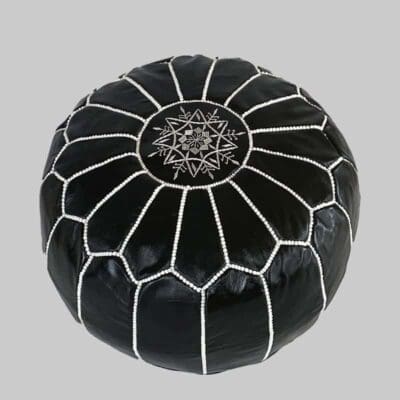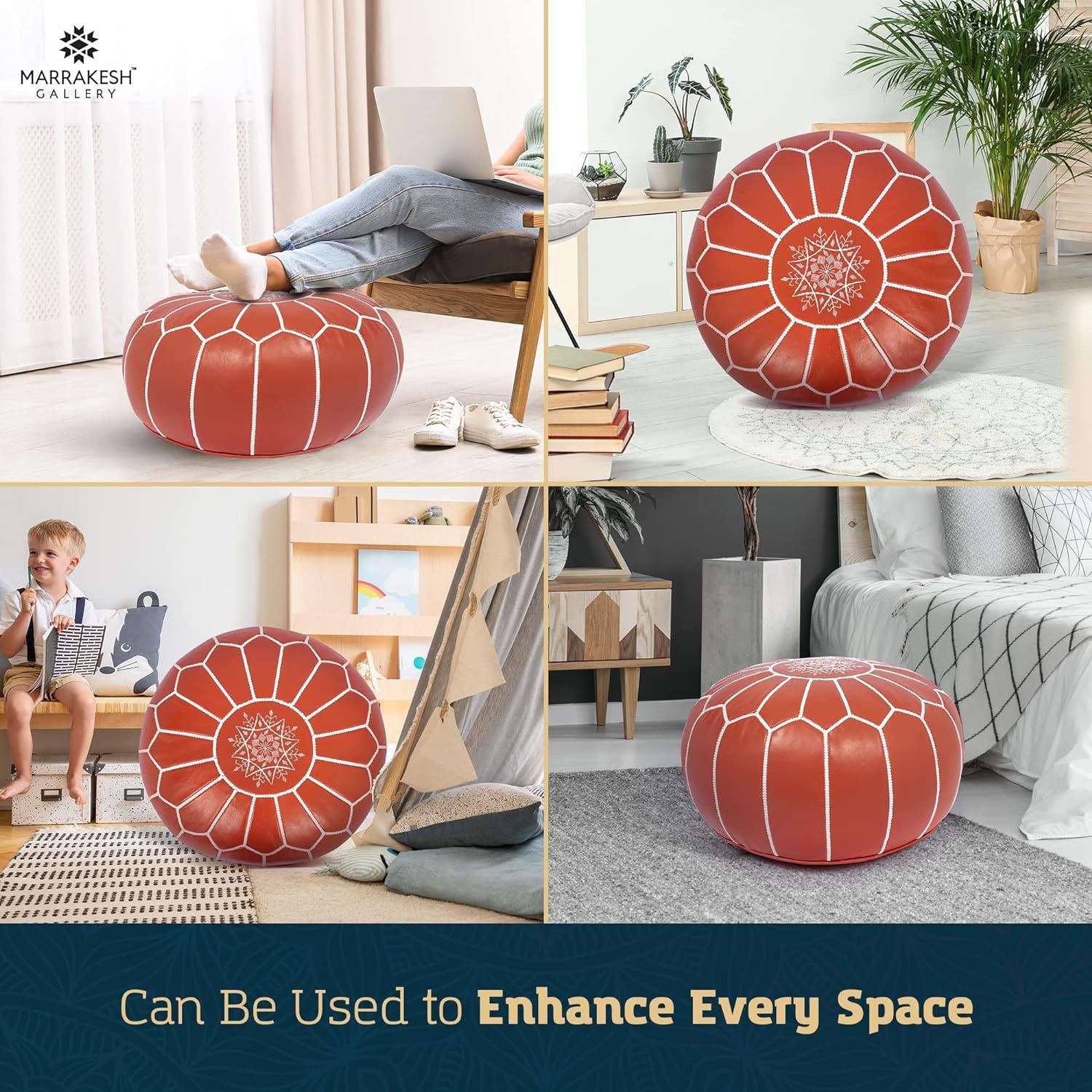Have you ever seen those beautifully crafted, colorful poufs in Moroccan homes or markets and wondered what they are really called? These unique pieces are more than just footrests or seats—they carry a rich history and culture that might surprise you.
If you want to learn the true name behind these stunning poufs and discover why they’re so special, keep reading. Your next home decor inspiration could be just a few words away!
Origins Of Moroccan Poufs
Moroccan poufs, known locally as “babbouche” or simply Moroccan poufs, hold a rich history. These handcrafted leather ottomans have origins that trace back centuries. They reflect the skilled craftsmanship and cultural traditions of Morocco. Their design and use speak volumes about Moroccan life and heritage.
Historical Background
Moroccan poufs date back to ancient Berber tribes. These tribes made poufs from natural leather and filled them with soft materials. The poufs served practical purposes as seating or footrests. Over time, artisans added decorative stitching and colors. This transformed poufs into beautiful art pieces. The tradition of making poufs passed down through generations. Today, poufs still hold their original charm and function.
Cultural Significance
Moroccan poufs symbolize hospitality and comfort. They are a staple in Moroccan homes and riads. Poufs bring warmth to living spaces and invite guests to sit and relax. Their intricate designs often tell stories of Moroccan culture. Each pouf is unique, representing local styles and craftsmanship. Poufs also play a role in social gatherings and celebrations. They blend function with artistry, making them treasured items across Morocco.

Credit: karajkom.com
Traditional Names For Moroccan Poufs
Moroccan poufs have a rich history reflected in the variety of names they carry across the country. These traditional cushions are more than just decorative pieces; their names often hint at the culture, craftsmanship, and regional identity behind each design. Understanding the traditional names for Moroccan poufs gives you a deeper appreciation of their role in Moroccan life and decor.
Common Terms And Variations
Most people simply call these poufs by the French term “pouf,” but in Morocco, there are several local names you might hear.
- Medfouna:This name often refers to a pouf that is stuffed or “buried” with filling, highlighting the handmade nature of the item.
- Tebaa:Commonly used in Berber-speaking regions, this term connects the pouf to traditional weaving techniques.
- Guerba:Sometimes used to describe poufs with intricate leatherwork, emphasizing the craftsmanship.
Each name points to a different style or crafting method, which can help you choose the right pouf for your taste and space.
Regional Differences
Morocco’s diverse regions add unique twists to pouf names. In Marrakech, you might find poufs called “Kharboucha”, known for their bold colors and geometric patterns. Meanwhile, in the Rif Mountains, the name “Azilal”is common, referring to poufs made with a specific type of wool and tribal symbols.
Does your decor style lean more traditional or modern? Knowing regional differences can guide your selection toward authentic designs that match your personal vibe.
Next time you shop for a Moroccan pouf, ask about its name. You might uncover a story as rich as the pouf’s texture.
Materials And Craftsmanship
In the vibrant world of Moroccan decor, poufs serve as a charming blend of style and function. Known locally as “poof” or “hassira,” these versatile pieces are celebrated for their intricate designs and exquisite craftsmanship. The materials and techniques used in their creation are integral to their unique appeal.
Leather And Fabric Choices
Moroccan poufs are often crafted from high-quality leather, usually sourced from goats or camels. This leather is soft yet durable, making it perfect for everyday use. You might find yourself drawn to the rich, earthy tones that leather offers, each piece telling its own story.
Fabric options include vibrant cottons and silks, reflecting the colorful Moroccan landscape. Patterns often feature traditional motifs and are hand-dyed with natural colors. If you prefer a softer touch, fabric poufs offer a cozy alternative to leather.
Handmade Techniques
Every Moroccan pouf is a testament to skilled craftsmanship. Artisans employ age-old techniques passed down through generations. Stitching is done by hand, with every seam meticulously sewn to ensure longevity.
Embroidery is a common decorative element, adding a layer of artistic flair. Artisans invest countless hours to perfect these intricate details. Have you ever thought about the dedication required to create such beauty?
Each pouf is a labor of love, reflecting the artisan’s passion and expertise. It’s not just a piece of furniture; it’s a piece of art. When you bring a Moroccan pouf into your home, you’re not just adding decor—you’re adding a story.
Design Styles And Patterns
Moroccan poufs are famous for their unique design styles and patterns. These designs tell stories of tradition and culture. They use rich colors and detailed work. Each pouf reflects skilled craftsmanship from local artisans. The patterns often blend geometry with nature. The style can be either classic or modern. Both styles keep Moroccan heritage alive in home decor.
Classic Embroidery
Classic Moroccan poufs often feature detailed embroidery. The stitches form geometric shapes and floral patterns. Artisans use vibrant thread colors like red, blue, and gold. This embroidery adds texture and depth to the pouf surface. Many pieces include symbols that represent protection or luck. The leather or fabric base is carefully chosen for durability. These poufs serve as both furniture and art pieces.
Modern Adaptations
Modern Moroccan poufs show a fresh take on tradition. Designers use simpler lines and softer colors. Some poufs mix leather with fabrics like cotton or wool. Patterns become less busy and more minimalist. This style fits well in contemporary homes. It keeps the Moroccan spirit but feels lighter and more versatile. Modern poufs often come in new shapes too, like cubes or hexagons.
Using Moroccan Poufs In Home Decor
Moroccan poufs, also known as “pouffes” or “ottomans,” add charm and comfort to any room. These handcrafted leather pieces bring a warm, cultural touch to home decor. Their versatility makes them perfect for different spaces in the house. They serve as footrests, extra seats, or decorative accents.
Living Room Ideas
Place a Moroccan pouf near your sofa for a cozy footrest. Use it as extra seating when guests visit. Its rich colors and patterns create a focal point. Combine poufs with neutral furniture to brighten the space. Group multiple poufs together for a casual, relaxed vibe. They also work well as small side tables with a tray on top.
Bedroom And Lounge Spaces
In bedrooms, Moroccan poufs add softness and style. Set one beside your bed for a spot to sit or lay clothes. Use them in reading nooks to create a comfy corner. Their compact size fits well in smaller rooms. Choose poufs with textures that complement your bedding. They bring warmth and a handmade feel to lounge areas.
Where To Find Authentic Poufs
Finding authentic Moroccan poufs requires knowing the right places to search. These poufs, known locally as “bouchouka” or simply Moroccan leather poufs, carry rich cultural heritage. Authentic pieces showcase traditional craftsmanship and unique designs. Two main sources offer genuine poufs: local markets in Morocco and select online retailers.
Local Markets In Morocco
Local markets, or souks, are the heart of Moroccan shopping. Cities like Marrakech, Fes, and Casablanca host vibrant souks filled with artisans selling handmade poufs. These markets offer a chance to see the quality and craftsmanship up close. Haggling is common and part of the experience. Buying here supports local artisans directly.
- Marrakech’s Souk Semmarine
- Fes’ Medina market
- Casablanca’s Derb Ghallef
Visiting these souks ensures authentic materials like genuine leather and traditional stitching techniques. The variety in color, size, and design is vast. Local markets provide the most authentic and culturally rich pouf shopping experience.
Online Retailers
Online shopping offers convenience for those outside Morocco. Some trustworthy websites specialize in genuine Moroccan poufs. These sellers often work directly with artisans. They provide detailed product descriptions and photos. Many offer worldwide shipping.
- Look for retailers with positive reviews
- Check for authenticity guarantees
- Choose sellers that disclose craftsmanship details
Online retailers can offer authentic poufs but verify details carefully. Authenticity, quality, and customer feedback matter most. This option suits buyers who cannot visit Morocco but want genuine poufs delivered to their door.
Caring For Moroccan Poufs
Moroccan poufs add a unique charm and warmth to any space. To keep their beauty lasting, proper care is essential. Understanding how to clean and maintain these poufs will help you enjoy their style and comfort for years.
Cleaning Tips
Moroccan poufs are often made from leather or woven fabrics, so cleaning requires gentle care. Use a soft cloth to dust your pouf regularly. This prevents dirt from settling into the material.
If your pouf is leather, try wiping it with a damp cloth and a mild soap solution. Avoid soaking the leather as excess water can cause damage. For fabric poufs, spot clean stains immediately using a mixture of water and mild detergent.
Have you ever noticed how a quick wipe can instantly brighten the pouf’s look? Small, regular cleaning keeps the vibrant colors and textures alive without harsh chemicals.
Maintenance Advice
Beyond cleaning, maintaining your Moroccan pouf involves protecting it from direct sunlight and moisture. Sun can fade colors, while moisture can lead to mold or leather cracking.
Rotate your pouf occasionally to prevent uneven wear, especially if you use it as a footrest. This simple step prolongs its shape and comfort.
Consider applying a leather conditioner every few months if your pouf is made of leather. This keeps the material soft and prevents drying out. Have you checked if your pouf needs conditioning lately?
With a little attention and care, your Moroccan pouf will remain a stunning and functional piece in your home.

Credit: tibladin.dk

Credit: giftsmorocco.com
Frequently Asked Questions
What Are Moroccan Poufs Traditionally Called?
Moroccan poufs are traditionally called “Ottomans” or “Moroccan poufs. ” They are handmade leather footstools or seats, often embroidered with intricate patterns.
What Materials Are Used For Moroccan Poufs?
Moroccan poufs are usually made from high-quality leather. They often feature hand-stitched designs with wool or cotton for filling, ensuring durability and comfort.
How Are Moroccan Poufs Crafted?
Skilled artisans handcraft Moroccan poufs using traditional sewing techniques. They stitch leather pieces together and add decorative embroidery, making each pouf unique and authentic.
Why Are Moroccan Poufs Popular In Home Decor?
Moroccan poufs add exotic charm and color to interiors. They serve as versatile seating, footrests, or decorative accents, blending well with various design styles.
Conclusion
Moroccan poufs are called “Berkas” or simply “Moroccan poufs. ” They add color and style to any room. These poufs are made from leather and often hand-stitched with care. They serve as seats, footrests, or decorative pieces. Owning one brings a touch of Moroccan culture to your home.
Simple, beautiful, and practical. A small piece of Morocco you can enjoy every day.





